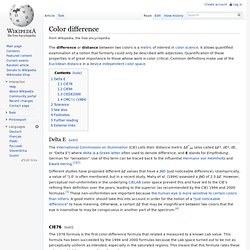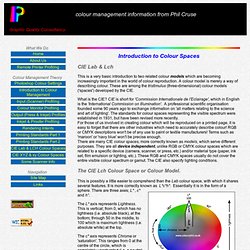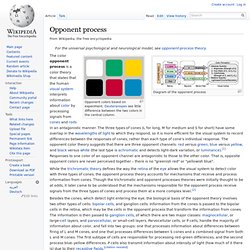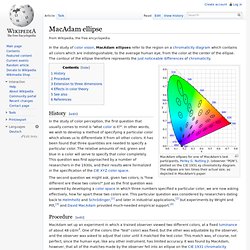

Color difference. Delta E[edit] Different studies have proposed different ΔE values that have a JND (just noticeable difference).

Unempirically, a value of '1.0' is often mentioned, but in a recent study, Mahy et al. (1994) assessed a JND of 2.3 ΔE. However, perceptual non-uniformities in the underlying CIELAB color space prevent this and have led to the CIE's refining their definition over the years, leading to the superior (as recommended by the CIE) 1994 and 2000 formulas.[3] These non-uniformities are important because the human eye is more sensitive to certain colors than others. A good metric should take this into account in order for the notion of a "just noticeable difference" to have meaning. Otherwise, a certain ΔE that may be insignificant between two colors that the eye is insensitive to may be conspicuous in another part of the spectrum.[4] CIE76[edit] Introduction to the CIE LCH & Lab Colour Spaces. This is a very basic introduction to two related colour models which are becoming increasingly important in the world of colour reproduction.

A colour model is merely a way of describing colour. These are among the tristimulus (three-dimensional) colour models ('spaces') developed by the CIE. What is the CIE? CIE is short for 'Commission Internationale de l'Eclairage', which in English is the 'International Commission on Illumination'. A professional scientific organisation founded some 90 years ago to exchange information on 'all matters relating to the science and art of lighting'. The CIE Lch Colour Space or Colour Model. This is possibly a little easier to comprehend than the Lab colour space, with which it shares several features. Opponent process. The color opponent process is a color theory that states that the human visual system interprets information about color by processing signals from cones and rods in an antagonistic manner.

The three types of cones (L for long, M for medium and S for short) have some overlap in the wavelengths of light to which they respond, so it is more efficient for the visual system to record differences between the responses of cones, rather than each type of cone's individual response. The opponent color theory suggests that there are three opponent channels: red versus green, blue versus yellow, and black versus white (the last type is achromatic and detects light-dark variation, or luminance).[1] Responses to one color of an opponent channel are antagonistic to those to the other color. That is, opposite opponent colors are never perceived together – there is no "greenish red" or "yellowish blue".
An09_96a. Lab color space. The CIE 1976 (L*, a*, b*) color space (CIELAB), showing only colors that fit within the sRGB gamut (and can therefore be displayed on a typical computer display).

Each axis of each square ranges from -128 to 128. The dimensions of the Hunter 1948 L, a, b color space are L, a, and b.[1][2] However, Lab is now more often used as an informal abbreviation for the CIE 1976 (L*, a*, b*) color space (or CIELAB). The difference between Hunter and CIE color coordinates is that the CIE coordinates are based on a cube root transformation of the color data, while the Hunter coordinates are based on a square root transformation.
The L*a*b* color space includes all perceivable colors, which means that its gamut exceeds those of the RGB and CMYK color models (for example, ProPhoto RGB includes about 90% all perceivable colors). MacAdam ellipse. In the study of color vision, MacAdam ellipses refer to the region on a chromaticity diagram which contains all colors which are indistinguishable, to the average human eye, from the color at the center of the ellipse.

The contour of the ellipse therefore represents the just noticeable differences of chromaticity. MacAdam ellipses for one of MacAdam's test participants, Perley G. Nutting Jr. (observer "PGN"), plotted on the CIE 1931 xy chromaticity diagram. The ellipses are ten times their actual size, as depicted in MacAdam's paper. History[edit] In the study of color perception, the first question that usually comes to mind is "what color is it? ". The second question we might ask, given two colors, is "how different are these two colors?
" Procedure[edit] MacAdam set up an experiment in which a trained observer viewed two different colors, at a fixed luminance of about 48 cd/m2. Extension to three dimensions[edit] Effects in color theory[edit] See also[edit] Konica Minolta Optical Spectrophotometer or CM-2600d Spectrophotometer.